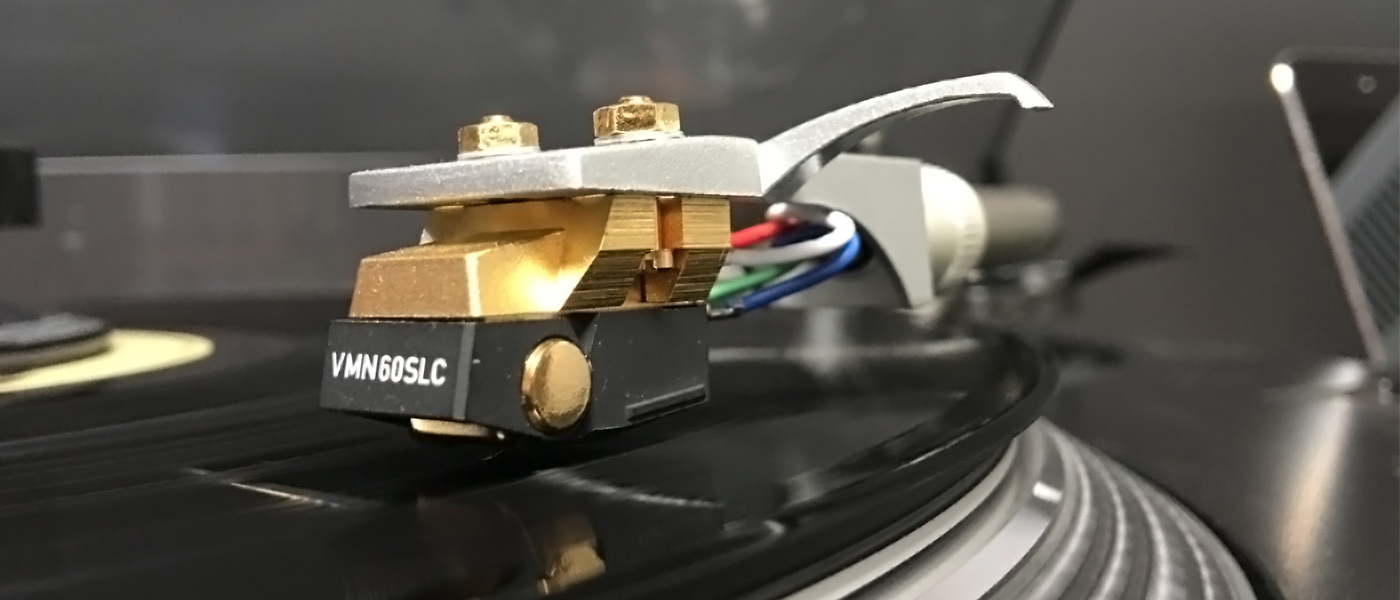
They range in price from a few hundred dollars up to several thousand. They are well respected, and for good reason. Their products are very high quality.
The Pro-Ject RPM 9 Carbon turntable is in their middle range, at $2,499, and it includes a 9” Evo carbon-fiber tonearm. As the name implies, the tonearm is made from carbon fiber. This minimizes resonance of the tonearm as it is exposed to various frequencies that the cartridge is tracking.
The Pro-Ject Tube Box DS2 phono preamplifier is in the proper price range ($799) for the Pro-Ject RPM 9 Carbon turntable. I think that one should not go overboard when selecting the various components to go together for a turntable and preamp setup. So, for example, in my opinion, the phono preamp should cost about 1/3 the cost of the turntable, and the cartridge should cost about ½ to 2/3 the cost of the turntable. Of course, this is flexible, but in general, a good approximate.
A Sumiko Starling MC phono cartridge was supplied with the RPM 9 Carbon turntable and Tube Box DS2 preamplifier. It is a low-output (0.5 mV) design.
Pro-Ject RPM 9 Carbon Turntable
Design:
Turntable with 9” Evo Tonearm
Plinth:
MDF, Carbon, and Steel Pellets
Bearing:
Inverted Ceramic
Platter:
7.2 kg (16 pounds) Aluminum
Feet:
Magnetic Air Suspension
Wow & Flutter:
33 RPM: +/- 0.60%; 45 RPM: +/- 0.60%
Tonearm:
9” CC EVO Carbon Fiber
Arm Bearing:
Gimble
Arm Mass:
8 gm
Cable:
5 Pin DIN
Power Supply:
15 Volts DC
Dimensions:
180 mm (7.1”) H x 440 mm (17.3”) W x 325 mm (12.8”) D
Weight:
16.5 kg (36.4 pounds)
MSRP:
$2,499 USA
Pro-Ject Tube Box DS2 Phono Preamplifier
Design:
Dual Triode
Tube Compliment:
Two 12AX7
Post-Emphasis Curve:
RIAA – +/- 0.2 dB / 20 Hz – 20 kHz
MC/MM Compatible
Inputs:
Two Sets of 2 RCA Gold-Plated
Outputs:
2 RCA Gold-Plated
Input Impedance Loading:
47 kOhm Fixed, 10-1000 Ohm Variable
Input Capacitance Loading:
100, 220, 320 pF
Gain:
40, 45, 50, 60, 65 dB
Output Voltage:
500 mV
THD:
0.04%
SNR:
88 dB
Subsonic Filter:
20 Hz, 12 dB/Octave
Power Supply:
18 Volts DC
Dimensions:
93 mm (3.7”) H x 240 mm (9.5”) W x 227 mm (9”) D
Weight:
1.96 kg (4.3 pounds)
MSRP:
$799 USA
Company:
Sumiko Starling MC Phono Cartridge
Design:
MC (Moving Coil)
Cantilever (Needle):
Boron
Coil Wire:
Copper
Internal Impedance:
28 Ohms
Load Impedance:
100 Ohms
Frequency Response:
12 Hz – 50 kHz
Output Voltage:
0.5 mV
Channel Separation:
35 dB @ 1 kHz
Channel Balance:
0.5 dB @ 1 kHz
Compliance:
12×10-6 cm/dyn @ 100 Hz
Recommended Load Capacitance:
100 pF – 200 pF
Vertical Tracking Angle:
200
Tracking Force:
1.8 gm – 2.2 gm
Recommended Tracking Force:
2 gm
Cartridge Weight:
9.5 gm
MSRP:
$1,899 USA
Company:
SECRETS Tags:
Pro-Ject, Sumiko, Sumiko Cartridge, Pro-Ject Turntable, Pro-Ject Tube Box, Pro-Ject Preamplifier, Cartridge Review 2018
The platter is heavy (16 pounds), and heavy is good. It results in low resonant response to loud dynamics from the music playing from speakers, but also, low wow & flutter.
The plinth (base) is a mixture of MDF, carbon, and steel pellets. This mixture has low resonance, like the platter, and therefore, low transmission of vibrations from the music to the cartridge.
The overall footprint is quite compact, so the turntable will fit just about anywhere. For the review, I placed it on a small table, shown below.
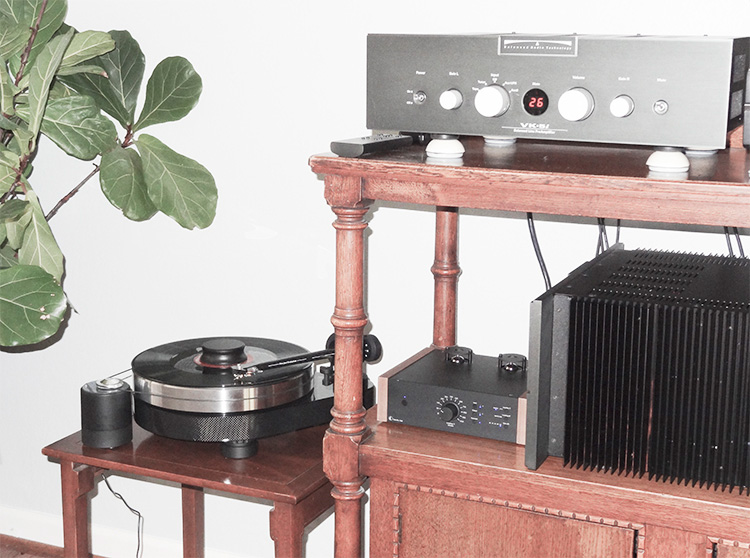
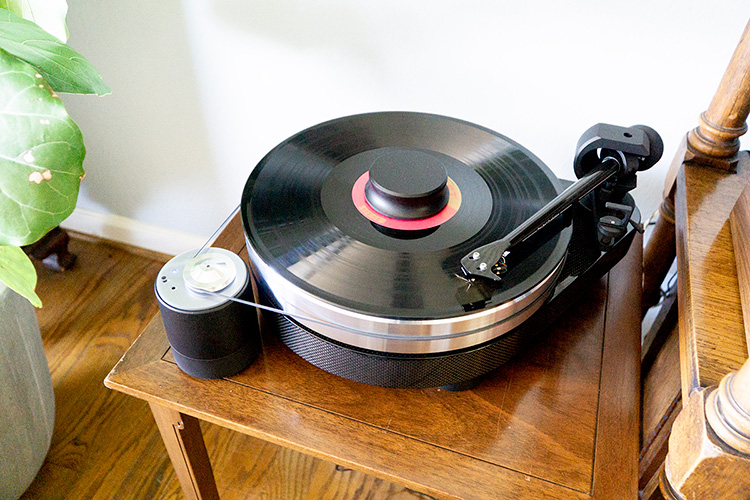
Sumiko offers a wide range of cartridges that will fit any budget. The supplied cartridge, the Sumiko Starling, is an MC (Moving Coil) cartridge. What this means is that there are two small coils of wire at the top end of the cantilever (the “needle”) arranged at 900 from one another. When the stylus (the diamond tip at the bottom end of the cantilever) moves side-to-side (laterally) or top-to-bottom (vertically) in the LP groove, the coils at the top also move. They are situated in a permanent magnet’s magnetic field, so that when they (the coils) move, an electric current is generated in the coils, one for the left channel and one for the right. This current is fed to the phono preamplifier, which applies a “Post-Emphasis” (“De-Emphasis”) curve, called the RIAA. Basically, it boosts the low frequencies and attenuates (reduces) the high frequencies, before sending the phono preamplified output (about 500 mV to 1 volt) to the main preamplifier. When the LP was manufactured, a “Pre-Emphasis” RIAA curve was applied to the musical signal, attenuating the low frequencies and boosting the high frequencies. This is done so that the lateral distance in the groove is the same for all frequencies. If this were not done, the low frequencies would have a large lateral movement in the groove, and the high frequencies would have a very small lateral movement. This, in turn, would cause the stylus to jump out of the groove when loud bass occurred in the music. Secondly, because the lateral movement in the groove would vary a lot, the low frequencies would overlap between grooves. The Post-Emphasis RIAA curve restores the original loudness level of all frequencies. The crossover point for the RIAA curve is 1 kHz, meaning that a 1 kHz musical signal is not boosted or attenuated.
The turntable is shipped completely disassembled, so you need to plan on an entire morning or afternoon for setup.
I unpacked all of the parts and placed them on a large table.
Then, I assembled the plinth (base), which entails screwing on the feet. They have powerful magnets inside, and when the turntable is placed on a table, magnets in the lower and upper parts of the feet repel each other, producing an air suspension.
The platter was then placed on the center spindle.
I adjusted the feet by screwing or unscrewing them so that the platter was level, as indicated by a bubble level. To do this, I lifted the plinth near the foot that I wanted to adjust, with one hand, and then turned the foot with the other.
Secrets Sponsor
You need to adjust the base so that the bubble level is centered regardless of which way the level is rotated. This can take some time because adjusting each of the feet lifts or lowers the plinth in two dimensions.
Then, I set up the motor by placing it at the side of the turntable, adding the rubber belt over the motor pulley and the platter, and adjusting the distance between the motor and the platter using the included plastic guide, shown below. You place the guide over the motor, with the center of the hole in the guide over the center of the motor, and the outer edge flush against the platter.

A final check with the bubble level, and the motor alignment is done.
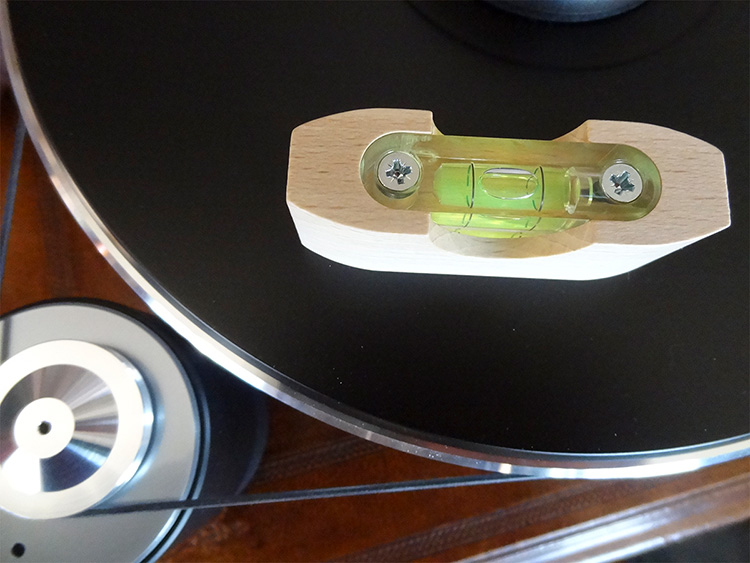
Next, I removed the wire that bound the tonearm to the tonearm holder (tonearm rest).
Noting the weight of the Sumiko Starling cartridge, I selected the appropriate counterweight (four counterweights are supplied). I screwed the counterweight onto the rear of the tonearm.
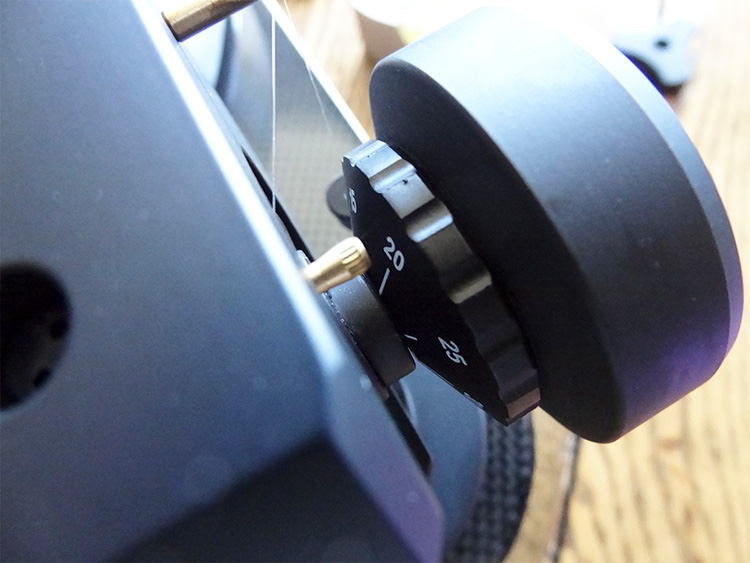
I then attached the Sumiko Starling cartridge to the front end of the tonearm.
The four color-coded conductors are then attached to the color-coded pins on the rear of the cartridge.
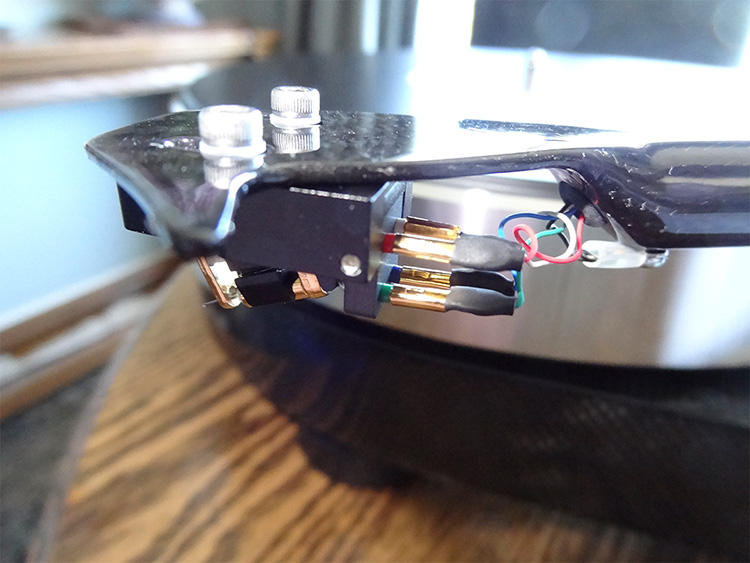
Next, I adjusted the counterweight so that the tonearm floated horizontally (did not go up or down when released). Then, I turned the counterweight dial so that it read “20”, which indicated a tracking force of 2 grams. Using a precision digital tracking force gauge, I found that it was not exactly 2 grams, so I adjusted the counterweight until it read 2 grams on the tracking force gauge. The digital tracking force gauge does not come with the turntable or cartridge. It is an optional accessory, and one that I highly recommend, as it is important to have an accurate tracking force. You can find this gauge on the Accessories page of the Pro-Ject website. Having a precisely accurate tracking force will extend the life of your expensive LP collection (as well as the stylus).
The Horizontal Tracking Angle (HTA), also called the Lateral Tracking Angle, is the tangential angle of the stylus as it sits in a groove on the LP. The front of the cartridge needs to be parallel to a line from the center spindle to the outer edge of the LP. This is accomplished using a protractor guide. One comes with the turntable, but it is small. A larger one is available from Pro-Ject in their Accessories section. I used one that came with a test LP. Using the protractor, one adjusts the cartridge so that it is parallel to the protractor guide.
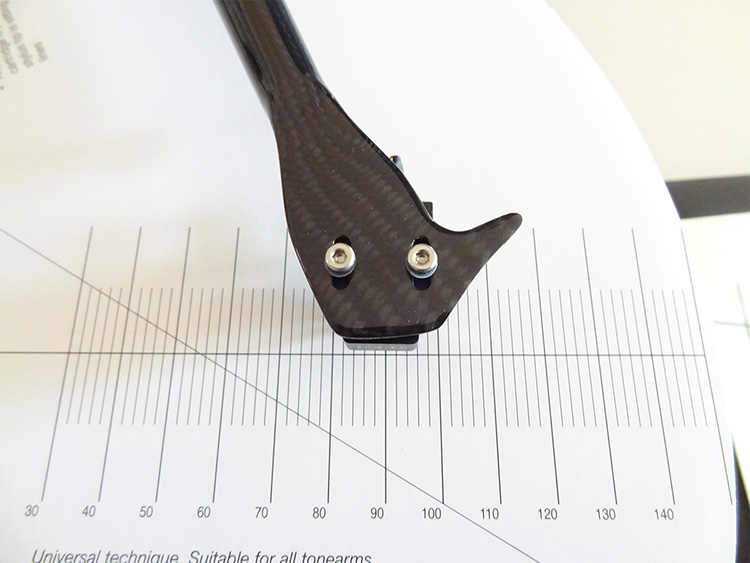
The cartridge moves in an arc across the LP, so it is only at the proper tangent at one place. You have to choose where that place is. I chose a spot that is midway between the outer edge of the LP and the beginning of the lead-out groove at the end of the LP.
The Vertical Tracking Angle (VTA) is the angle of tilt, nose down or nose up, that the cartridge has when the stylus is in the record groove. After mounting the cartridge, the VTA needs to be adjusted by leveling the tonearm. On the Pro-Ject RPM 9 Carbon, this is done by loosening two hex screws at the rear of the tonearm, then lifting or lowering the tonearm until it is level with respect to an LP on the platter. Hex wrenches of various sizes, required for assembling and adjusting the turntable, are included. Here is a photo of the rear of the tonearm, showing the two sockets where the hex screws for adjusting the VTA are located.
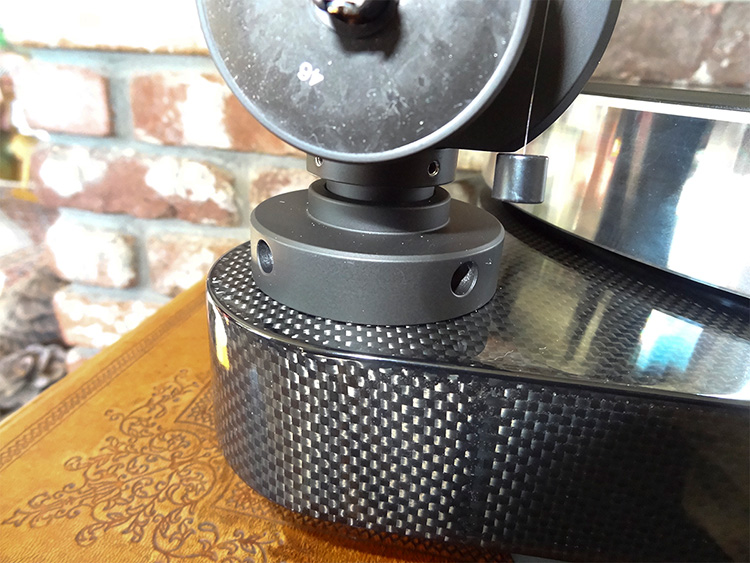
To do this, you insert the hex wrench in the two sockets, loosen the hex screws (hold on to the tonearm so that it does not collapse down onto the LP), and then move the tonearm up or down until it is level (the space between the tonearm and an LP), as shown in the photo below.

The Azimuth refers to having the cartridge not tilted to the left or right, i.e., when looking at the front of the cartridge, not having the left side closer or farther from the surface of the LP than the right side, and more specifically, the cantilever is vertical.
To do this on the RPM 9 Carbon, you loosen a hex screw on the side of the tonearm, as shown below. The screw is just to the left of the number 25 on the tracking force dial.

When the screw is loose, you rotate the tonearm until the cartridge cantilever is vertical when resting on an LP. Note: raise the tonearm with one hand and rotate it with the other hand. Do not rotate the tonearm while the stylus is resting on the LP. Once it is vertical, tighten the hex screw (with the tonearm raised).
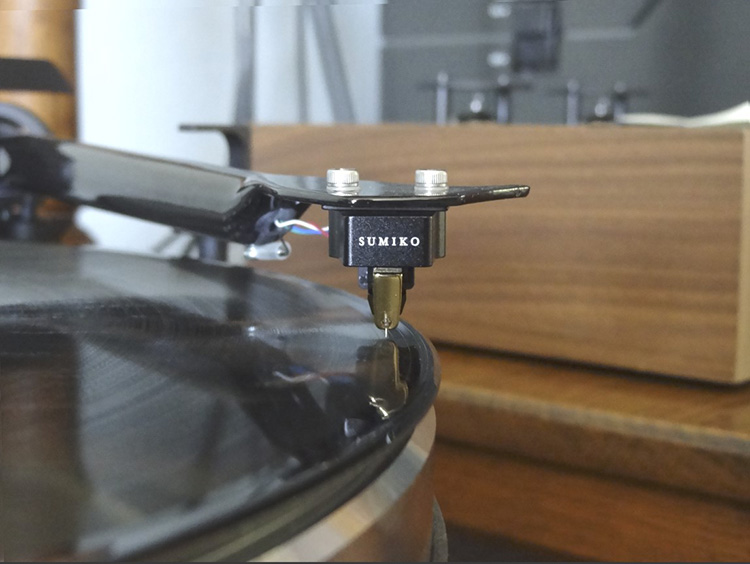
When playing an LP, there is a tendency for the stylus to move towards the center spindle because the grooves near the center are rotating at a lower linear velocity than grooves near the outer edge (the inner grooves are smaller diameter).
The solution to this is the Anti-Skate control. It consists of a small, light weight, attached to a filament that is attached at the other end to the tonearm. The filament is suspended over a rod. Depending on the tracking force, the filament is suspended on the rod, closer or farther from where the rod is attached to the tonearm.

You can see the rod at the top, center, which is attached to the tonearm. The Anti-Skate filament is looped over that rod and also the rod on the right, center, then the weight is suspended.
Here is another photo (below) at an angle that shows the filament, weight, and rods in a better light.
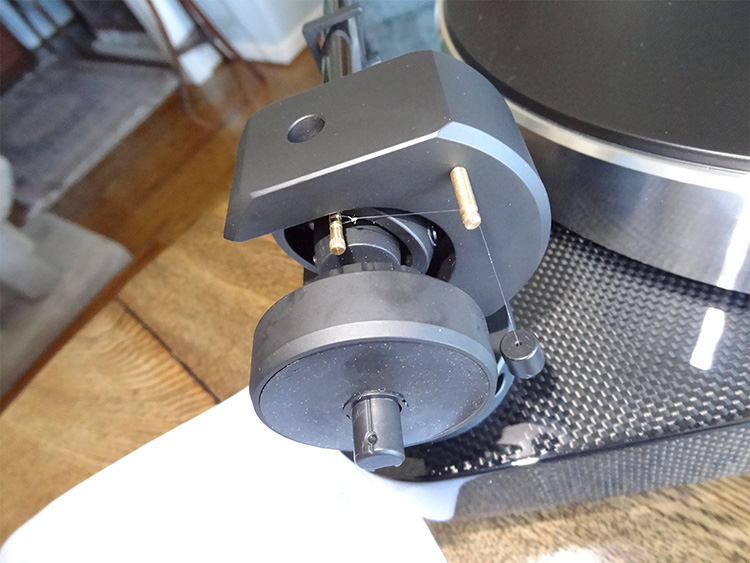
The Pro-Ject Tube Box DS2 phono preamplifier has two 12AX7 dual triodes. It is designed with the first triode as the input stage and is cascaded with a 2SK170 J-FET transistor. The gain of this stage is about 70. The second triode is used as a classic gain stage biased into pure class A.
I set the resistance load to 100 ohms and the capacitive load to 220 pF. I used a gain setting of 65 dB. The Subsonic Filter was turned on.

Here are the connections I used on the rear panel. There are two sets of inputs, and I used Input 1. Note that there is a ground wire from the turntable that is connected to the phono preamplifier in the upper left corner.

The motor is turned on by pressing the center button on the top. The 33 1/3 rpm light will illuminate. It is the one on the left. Pressing the power button again will illuminate the 45 rpm light. Holding the button down will turn the motor off.
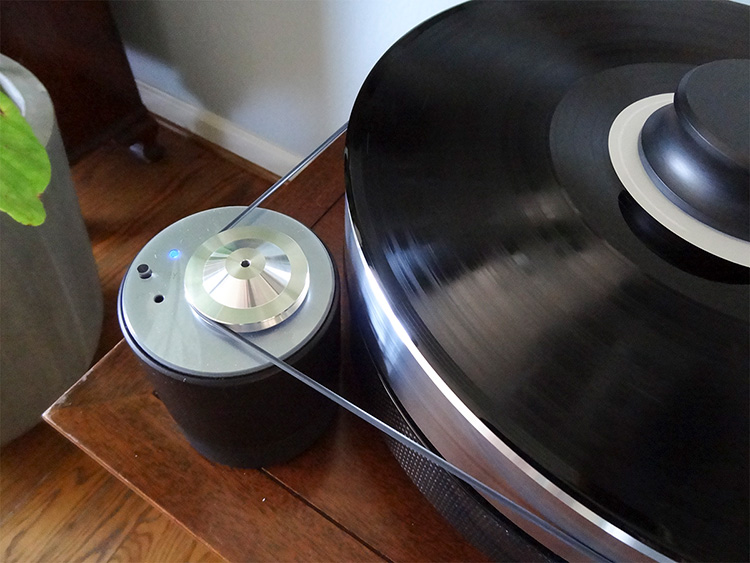
Besides the Pro-Ject RPM 9 Carbon turntable, Pro-Ject Tube Box DS2 phono preamplifier, and Sumiko Starling phono cartridge under review, I used a Balanced Audio Technology VK-5i Pure Class A Triode Preamplifier (Fully Balanced), Balanced Audio Technology VK-500 Solid State Stereo Power Amplifier (Fully Balanced) (250 Watts per Channel into 8 ohms), and Magnepan 20.7 Planar Magnetic Full-Range Speakers. Cables were Wireworld and Mogami.

I listened to some of my vinyl collection that includes albums that were recorded digitally and transferred to vinyl. One of these is Tchaikovsky’s 1812 Overture, conducted by Erich Kunzel with the Cincinnati Symphony Orchestra (ATEL 00009).
This album is important for testing vinyl and speakers, using either the digital version or vinyl version, because it has some very intense bass (cannons) during the climax sequence.
The turntable and cartridge tracked the cannons without any problem. I say turntable and cartridge because tracking is an issue that is affected by both items. If the tonearm suspension (gimbal in this case, as compared to pivot) is close to frictionless, and the cartridge cantilever is compliant, the stylus will stay effortlessly in the groove, which it did.
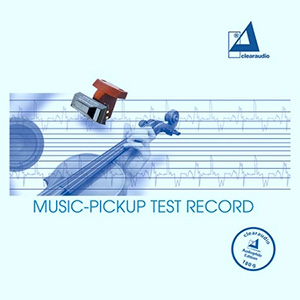
A second album for challenging music is the Clearaudio Music-Pickup Test Record (LP 43033). Again, the Pro-Ject turntable and Sumiko Starling cartridge performed well, without any issues. A typical track is J.S. Bach: Gelobet seist du, Jesu Christ, with Rune Engso on organ.
The pedal notes are the challenge, but the Pro-Ject and Sumiko did not blink.
And, even though it is a test LP, I enjoyed the musical selections for themselves compared to sine waves and noise (and silence too) on conventional test LPs.

Ah Rachmaninoff! In the movie “Doctor Shivago” (1965), there is a scene where some people are listening to a musician playing the piano. A child starts talking, and his mother says, “Be quiet and listen. This is genius.” The pianist is Sergei Rachmaninoff.
Unfortunately, this was a long, long time ago, way before my time, so I never got the chance to hear this genius in person. But, we can hear his fabulous music. This album (AMER 90283) showcases his Piano Concerto no. 3 (the “Rach 3”), played by Byron Janis and the London Symphony Orchestra, conducted by Antal Dorati. It was recorded on 35 mm magnetic tape, compared to conventional ½’ studio tape. This gave a better quality recording.
The performance is excellent, and it sounds terrific. The usual Rachmaninoff dynamics are in full display.

You can see that I like Tchaikovsky (another composer whose music will be around for eternity). In this case, his Symphony no. 5 (AEVC 3039-45). This particular recording, made on 35 mm magnetic tape, was mastered at 45 rpm, so it has two LPs (it is $55, but is worth it).
Tchaikovsky’s music usually has plenty of violins playing rich harmonies, and that is the case here. It is difficult to reproduce because there are so many frequencies occurring at the same time, but it presented no problem for the Pro-Ject and Sumiko system under test.
Many of my LPs are at 45 rpm. There is an advantage to this, and it does make the collection pretty expensive, but I consider this part of being an audiophile. It is an expensive hobby.

Franz Liszt is another of my favorite composers. His Hungarian Rhapsody no. 2 comes to mind. This recording (Mercury EURO S90235) is a very good one, with Antal Dorati conducting the London Symphony Orchestra.
What strikes me about old analog recordings, presented on vinyl, is the “realness” of the sound. In particular, the brass, and especially trombones. I can hear individual vibrations of each note.
It is amazing to me that, of all the test LPs out there, the test tracks on each LP are different. There does not seem to be a consensus of what tests should be standard, except for the wow & flutter test. So, I had to pick and choose from each of the test LPs that I have on hand.
Except where noted, these tests are system responses, meaning they reflect the turntable, the cartridge, and the phono preamplifier.
First, a 1 kHz sine wave, recorded at 0 dBu. The primary distortion peak is second-ordered. This is one of the reasons that vinyl sounds so good. Second-ordered harmonics are pleasing. The THD+N numbers are not truly reflective of the distortion because the RIAA Post-Emphasis boosts the bass, and this includes the low frequency noise. The RIAA curve boosts the bass below 1 kHz, with increasing amount as the frequency decreases.
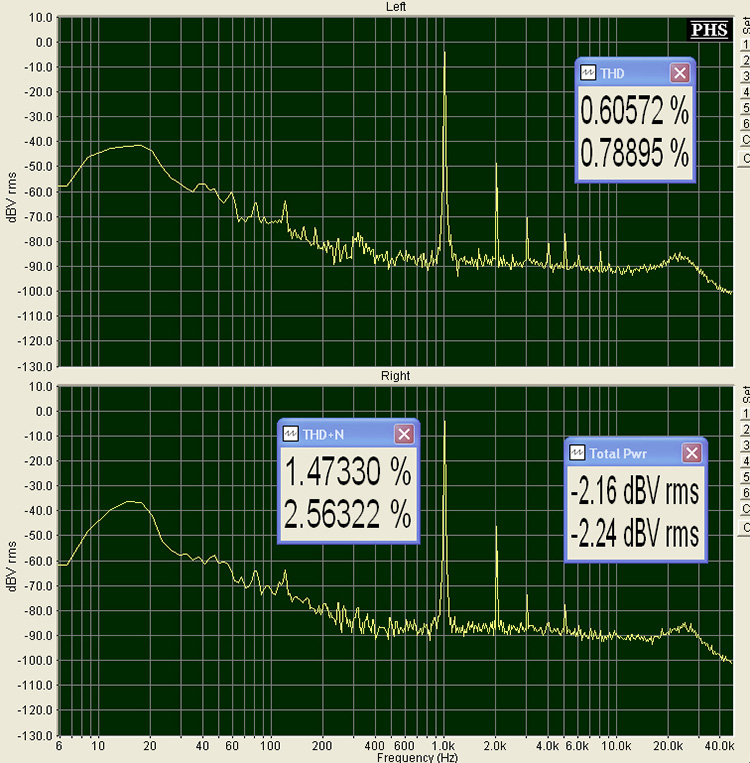
Now, a frequency response. The test tracks were divided into two separate tests, one for the high frequencies and one for the low frequencies. The high frequency track was at – 20 dB, while the low frequency track was at 0 dBU.
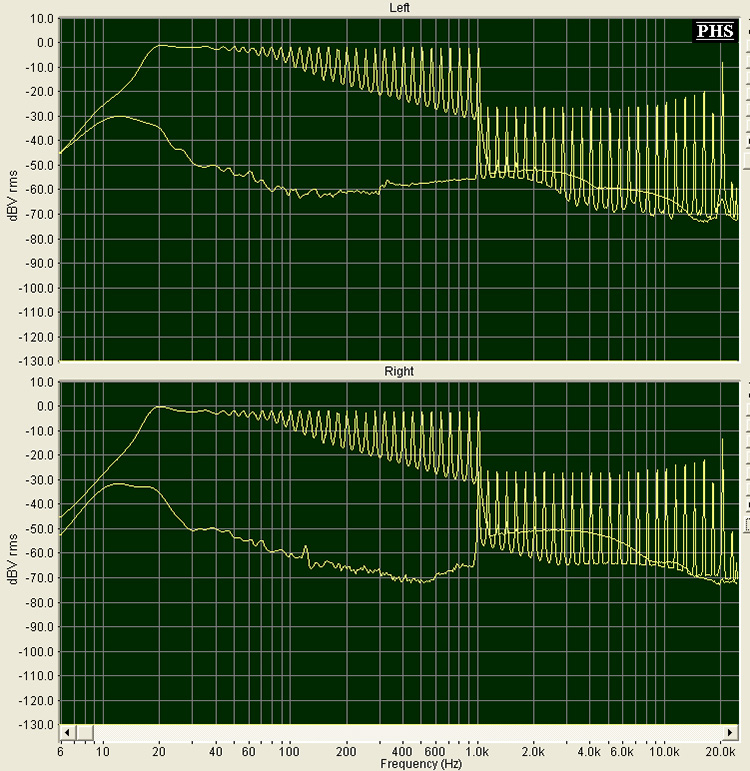
You can see the response is flat up to about 12 kHz and then begins to rise. This is not uncommon. The dip at 18 kHz is probably an artifact. The response drops rapidly below 20 Hz due to the subsonic filter that attenuates beginning at 20 Hz and increases at 12 dB/octave below 20 Hz.
I tested the cross-talk (channel separation) by using a 1 kHz sine wave only in the left channel. There was no groove signal in the right channel.
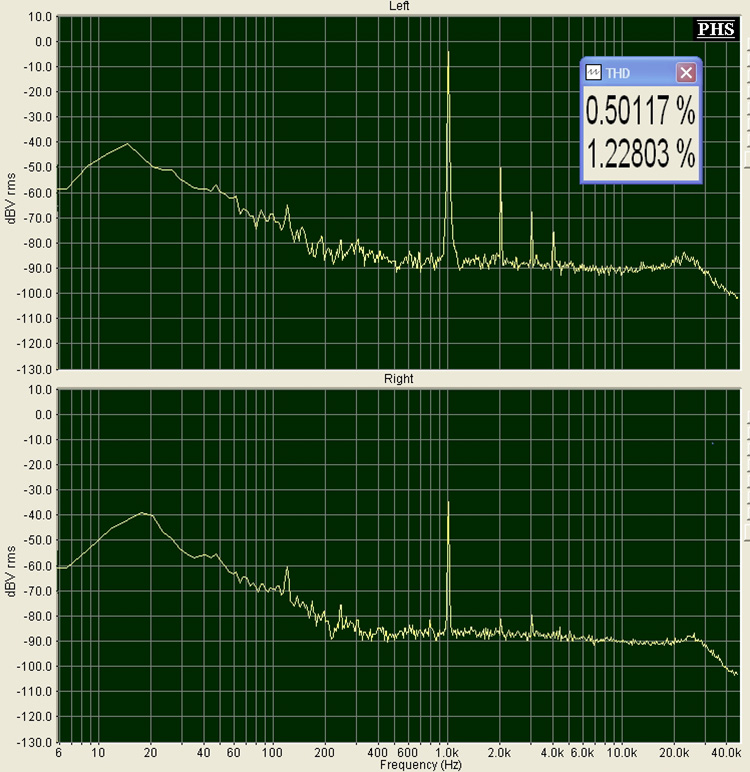
The cross-talk yielded a -41 dBV (-39 dBu) difference, meaning that the cross-talk in the right channel is -41 dBV lower than the signal in the left channel. This is a good result.
For a tracking capability test, I used a 300 Hz sine wave at + 15 dB. That is a very intense track and represents a peak level signal (0 dBu is the normal upper end recording level limit). The cartridge handled it beautifully, shown below.

Let’s look now at the spectrum when playing a silent groove (no music, just silence). Again, you can see that the low frequency noise is boosted, as per the RIAA Post-Emphasis (De-Emphasis).
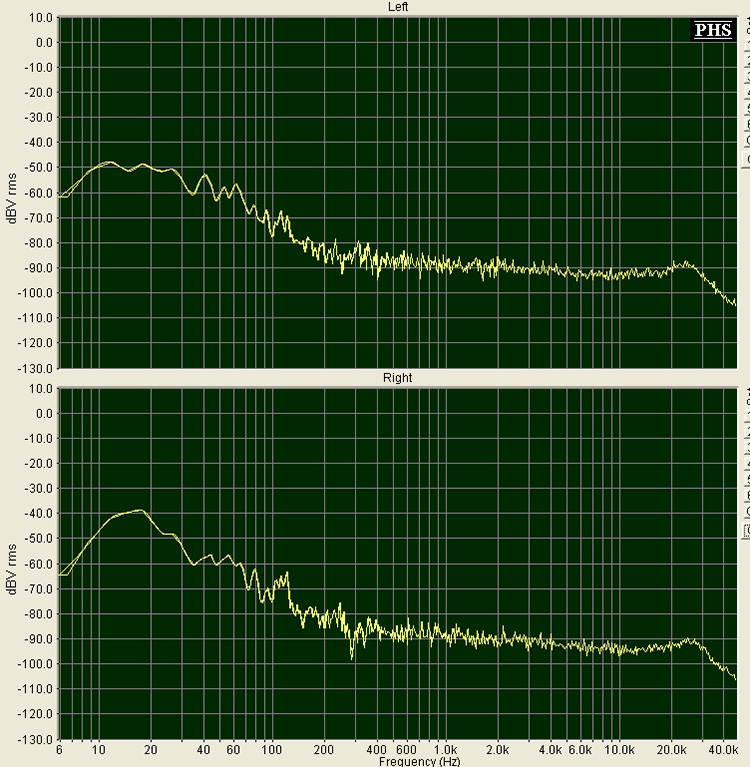
Compare that with just the Tube Box DS2 phono preamp, and no connection to the turntable.
With a 40 dB gain setting, the noise level is very low. That is the gain setting that I would use with a high output moving coil cartridge, e.g., the Sumiko Blackbird. (2.5 mV). There is some electrical noise at 60 Hz, 120 Hz, 240 Hz, etc., and at 20 kHz.
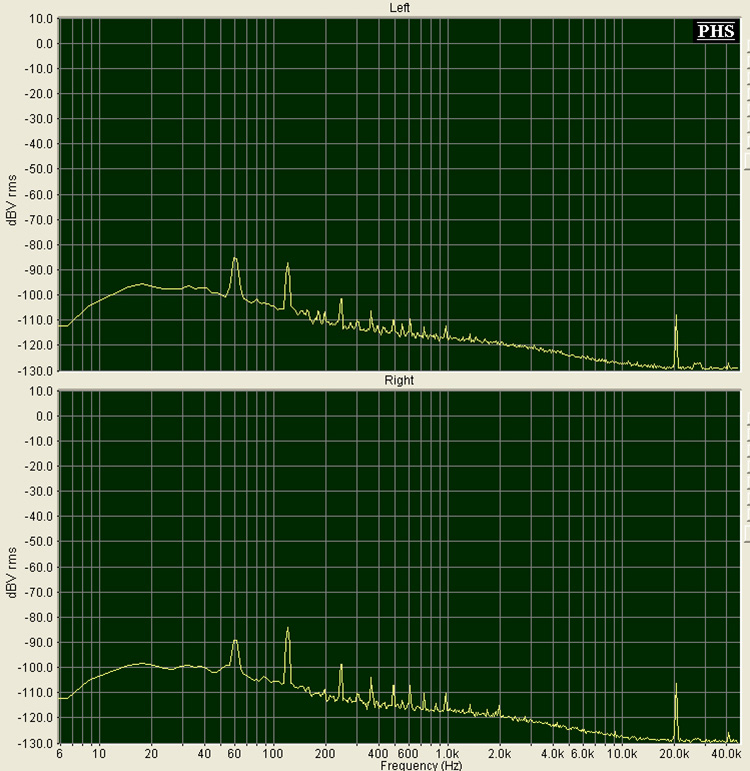
With the 65 dB gain setting that I used with the Sumiko Starling low output (0.5 mV) moving coil cartridge, the noise level is much higher. This is the compromise that has to be made with a low output cartridge. What you get in return is more detail, because the cantilever is lighter (the number of turns on the coils is lower, which results in lower output). When the stylus contacts the hills and valleys, and lateral displacements in the groove, it moves with those hills and valleys, and lateral displacements. A lighter weight cantilever is more easily moved, and thus, will reproduce small details better than a heavier cantilever in a high output cartridge. It is not necessarily a huge difference, but one that is noticeable, but this depends on the rest of the equipment in the signal chain as well.
Secrets Sponsor
I used the subsonic filter because it reduces the low frequency noise below 20 Hz.
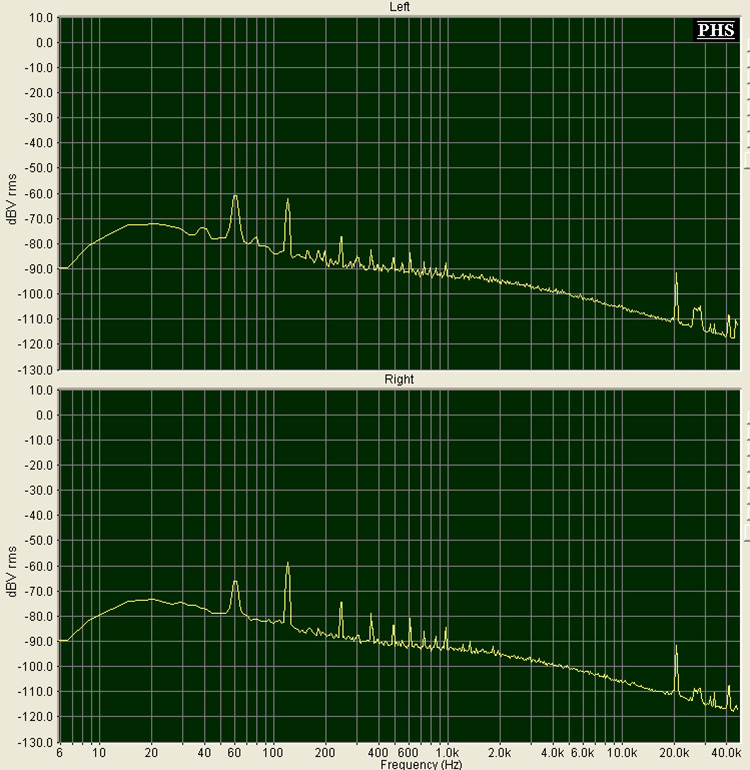
The wow & flutter test is shown below. It consists of a 3,150 Hz sine wave. The spectrum shows a peak at 3,150 Hz and then slopes down on either side. From the tests I have seen elsewhere with other turntables, my conclusion is that, if you draw an imaginary line from the peak at 3,150 Hz down to 3,050 Hz and a line from the peak at 3,150 Hz down to 3,250 Hz, any peaks above those diagonal lines would suggest moderate wow & flutter (typical of inexpensive turntables, i.e., $499), while a very good wow & flutter response would show no peaks above those diagonal lines. In the case of the Pro-Ject RPM Carbon 9 turntable, all the peaks are below the imaginary diagonal lines, which is what I would expect from a turntable of this caliber.
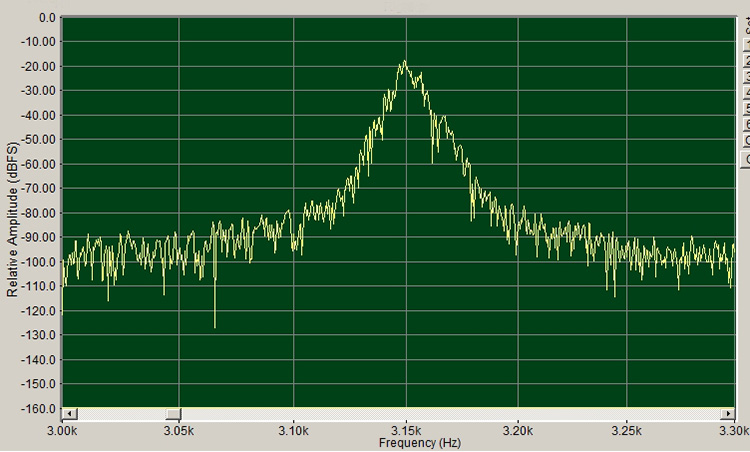
Pro-Ject RPM Carbon 9 Turntable:
- Low background noise.
- Heavy platter
- Easy setup
Sumiko Starling Phono Cartridge:
- Excellent detail
- Euphonic distortion
- Good tracking of high energy signals
Pro-Ject Tube Box DS2 Phono Preamplifier:
- Lots of features
- Euphonic distortion
Pro-Ject RPM Carbon 9 Turntable:
- Removable cartridge head
- Snap-lock tonearm rest
Sumiko Starling Phono Cartridge:
- No changes necessary
Pro-Ject Tube Box DS2 Phono Preamplifier:
- Balanced output. This would require another 12AX7 triode, and it would probably add $150 to the price, but it would double the output, which would be nice when using the 65 dB gain with a low output cartridge.
The Pro-Ject RPM 9 Carbon turntable is a fine product. It is silent and smooth. The accompanying Sumiko Starling cartridge amazed me with its tracking capability and the amount of detail in the music that it gave. The Pro-Ject Tube Box DS2 phono preamplifier is a good choice for this particular turntable. The three-part system delivered very euphonic distortion that analog-lovers will very much enjoy. If you want to get this turntable, and you don’t already have a cartridge and phono preamplifier, this is a package that really works well.


